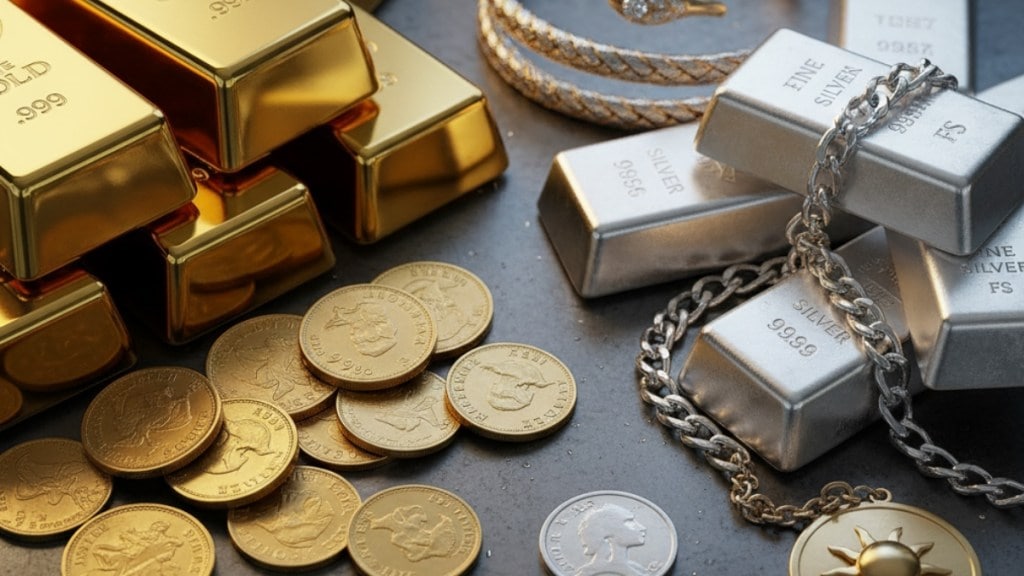Asset management companies have come out with gold-silver combo Fund of Funds (FoFs) for retail investors. As it is difficult for such investors to decide on how much and when to allocate to gold or silver, these funds can help them avoid timing the market and de-risk the portfolio exposure, explains Saikat Neogi.
What are gold and silver Fund of Funds
These are Fund of Funds (FoFs) which invest in the units of gold exchange traded funds (ETFs)and silver ETFs. These open-ended passive schemes are ideal for those investors who cannot decide on the optimal portfolio allocation to the two metals that have given the highest returns this year.
At present, four fund houses are offering the combo FoFs — Motilal Oswal, Mirae, Edelweiss and Kotak, which concluded its new fund offer on Monday. An in-house quantitative model determines the allocation between gold and silver based on their price movements.
The model allows for periodic rebalancing, helping capture relative value shifts between gold and silver. The fund manager also adjusts the allocation based on other relevant macro factors. Individuals can invest lumpsum amounts or through systematic investment plans and the funds are benchmarked to the domestic prices of gold and silver. Unlike ETFs, it is not mandatory to have a demat account to invest in FoFs.
Why are experts urging retail investors to bet on them?
Gold and silver offer good downside protection and tend to outperform in bear markets. Silver tends to outperform when the market is recovering from a bear phase and a combination of both offers optimal returns. As investing in precious metals offers a hedge against global uncertainties, a gold and silver FoF can offer retail investors a balanced strategy and de-risk exposure.These funds can help investors to potentially benefit from long-term appreciation in gold and silver, even with the current short-term volatility in the prices of the two metals. The combo FoF can protect against long-term downside in either of the two metals by rebalancing the portfolio. In fact, silver prices are very volatile and can remain depressed for extremely long periods.
For example, silver prices in the global market fell 75% from the highs of $48 per ounce in April 2011 to the lows of $12 per ounce in March 2020 and recovered to new highs this year.
Different from standalone gold or silver FoFs
Gold FoFs invest in gold ETFs, where each unit of the ETF is backed by physical gold. Similarly, silver FoFs invest in silver ETFs. Due to a significant supply deficit of physical silver in the spot market, silver ETFs are currently trading at a premium on the exchange. Once the physical supply situation stabilises, the premium is expected to normalise, which could affect short-term returns. As a result, six fund houses have suspended new investments in silver ETF FoFs, though existing SIP contributions have been allowed to continue. Silver ETFs, though, remain open for direct subscriptions.
In contrast, gold ETFs have a more stable physical market and are less affected by such premiums. In the domestic market, inflows into silver ETFs have more than doubled to `14,000 crore in the January-September period, compared with `6,500 crore in the same period last year. Inflows into gold ETFs have grown 2.7 times to `19,800 crore during the same period.
Returns from the precious metals
Gold prices have been driven by geopolitical tensions and silver too has joined the sprint on the back of strong investor inflows and tight supply in the spot market. In the last one year, domestic gold prices have risen 65% and silver prices have shot up by 95%. Over a three-year period, gold and silver have yielded 36% and 47% returns, respectively. Throughout 2025, gold dazzled the markets, recording 39 new all-time highs. However, last week, both gold and silver witnessed a sharp decline from their recent peaks, marking a potential trend reversal after historically overbought levels. In the international market, gold had fallen the most in over a decade last Wednesday and even silver recorded its steepest one-day decline since February 2021. Central banks led by China, India and Turkey have made record purchases of gold, underlining a gradual diversification away from the US dollar. On the other hand, the demand for silver has outstripped supply for five consecutive years pushing up global prices. Over half of silver demand now comes from industrial users.
Taxation of gold and silver FoFs
Just like ETFs, if gold silver FoFs are held for more than 24 months, the profit will be classified as a long-term capital gain and will be taxed at 12.5% flat without the indexation benefit. If an investor sells before that, it will be considered a short-term capital gain, added to the individual’s income and taxed at his applicable income tax slab rate. Non-resident Indians (NRIs) can invest in these gold and silver FoFs, unlike Sovereign Gold Bonds (SGB), as per RBI and FEMA norms. The tax rates for NRIs are the same as for Indian residents. However, TDS applies to gold and silver FoF on redemptions only for NRIs. In fact, sale of gold and silver in any form will attract capital gains tax, except for SGB if held till maturity of eight years.


